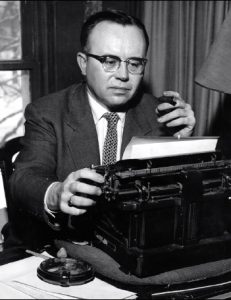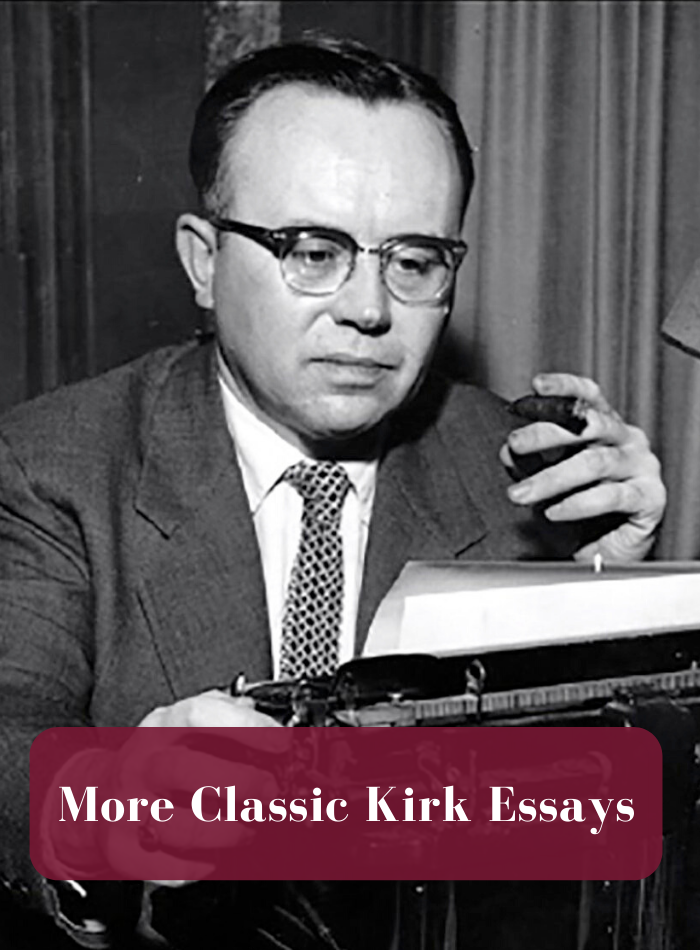
A note from Cecilia Kirk Nelson
Very few people will have come across Russell Kirk’s introduction to the ghostly tales penned by his friend Canon Basil Smith. Not having thought to tell Canon Smith during his lifetime how much he enjoyed the stories, Kirk secured a publisher and wrote the introduction to the collection in “an endeavor to make amends.”
This is one of my favorite essays by my father. It is suffused with gratitude for Canon Smith’s friendship and conveys his profound influence on my father, including on his spiritual understanding. “Our friendship haunts me, for my good,” Kirk wrote.
“The Canon of the Ghostly Tales”
Russell Kirk’s introduction to The Scallion Stone by Canon Basil A. Smith (Whispers Press, 1980)
Basil Smith, whose uncanny stories are published here a decade after his death, was no phantom. A tall, humorous, cordial, learned Yorkshireman, my friend the Reverend B. A. Smith, B.A., M.A. (Durham), was such a clergyman in the Church of England as we find rarely in these bent times. He spent most of his life in the ancient city of York, every quaint corner of which he knew. These original tales of his were written for his private diversion; I think he showed them to few beside myself; he would be surprised and pleased to find them published as a book in America.
We met in 1949—providentially, I believe. Wandering about York between trains, late on a somewhat sepulchral day, I happened to enter the little medieval church of St. Martin-cum-Gregory, in Micklegate, near the River Ouse, and admired the painted glass in its windows. Then I scurried off to catch a train to Edinburgh; but I forgot my walking-stick, which I had leaned against a wall of the church porch. From my Scottish residence, I wrote to the rector of the larger ancient church of Holy Trinity, Micklegate, who had St. Martin-cum-Gregory in his charge also. (Indeed, he had saved that little church from demolition.) He posted my stick to me and invited me to call when next I might visit York. That I did, and so commenced one of my closest and most rewarding friendships.
For B. A. Smith, Rector of Holy Trinity, Micklegate, turned out to be a generous, kindly, most interesting man, and we shared many tastes. Among other things, we both relished ghostly narrations. In his large library was a fine collection of the books of Sheridan LeFanu; on visits to the rectory, often long ones, I used to read in leisurely fashion the first edition of LeFanu’s neglected two-volume romance The House by the Churchyard. No book could have been more appropriate to the place, for the grounds of that rectory covered the old monks’ graveyard (Holy Trinity being the remnant of a medieval priory), and somehow the monks’ skulls and other reminders of mortality were forever surfacing, as if pushed up, in the Smiths’ garden; the janitor always burnt them in the furnace. Also the noble church itself, with its twelfth-century nave, had been notoriously haunted, not many years before, by apparitions which used to pass in silhouette against a great stained-glass window.
Mr. Smith’s parish, exclusively fashionable in the nineteenth century, over the decades had turned into a working-class neighborhood, some of it howling slum. Basil Smith had renewed Christian belief in that venerable parish of his, by kindliness and sensible sermons; of the seventeen old parish churches surviving within the walls of York, only two remained real houses of worship, and his church was one of those two.
His rectory was a peaceful dignified place, handsomely furnished with pieces which the Smiths had picked up prudently at sales; I loved particularly their doxological clock, chiming “Praise God from whom all blessings flow” every quarter of the hour. Mrs. Smith served the most sumptuous afternoon teas anywhere in Britain. The Smiths’ Siamese cats, with their mysterious ways, embellished this oldfangled charmed setting.
For all his hard work in his parish, Basil Smith was a considerable antiquary and a sound scholar. His book Dean Church: the Anglican Response to Newman (Oxford University Press, 1958), really a life of that great Anglican R. W. Church, is one of the best things by any English churchman in recent decades. He was vigorous in the preservation of York’s architectural patrimony, being a founder and a pillar of the York Georgian Society and a member of the council of the York Civic Trust. To walk the streets of the city with him, while he pointed out old curiosities and pleasantly told of old corners and old ways, was a delight which no one will experience again in its fullness: for much that he endeavored to save has been swept away by Philistines, though also he and his friends succeeded in preserving a good deal.
Basil Smith was made a canon of York Minster in 1961, and Canon Treasurer of the Minster in 1963. He and his wife, Phillis, moved to a beautiful roomy medieval-and-seventeenth-century house in the cathedral close, with the city walls at the back of its garden; there I used to stay with them until Canon Smith’s death in 1969. As Treasurer, my friend had in charge properties possessed by the cathedral chapter since the Middle Ages, and preserved them for posterity; also he took a principal part in the restoration of the Minster. He knew that the “contract of eternal society” which joins dead and living and those yet unborn finds its expression, in part, through the visible fabrics of a culture.
“We are living at the end of an age,” he told me, as we sat by the fire in his parlor. “The old civilization is dissolving rapidly about us.”
Like T. S. Eliot, whom he much admired, Canon Smith did what he could to redeem the time, in the order of the soul and the order of the commonwealth—although he was convinced, with Eliot, that probably no more could be done than to keep glowing through dark centuries a spark which some future generation might use to rekindle the warming fires of a culture moved by love and beauty.
So much might be written about this good and able man, practical, tireless, endowed with moral imagination! Had there been a hundred more like him, the condition of the Church in England today might be very different. But our present concern is his uncanny tales, set in the north of England that he knew so well—Yorkshire, Durham, Northumberland.
These stories, if similar in some respects to M. R. James’s, nevertheless bear the mark of B. A. Smith’s original fancy and literary skill. They are intricately wrought and satisfyingly lengthy. Into them are woven, doubtless, fragments of local legends and of personal experience. Canon Smith knew that the whole of our existence is suffused with mysteries, and that pitfalls are dug for the vagrant erring soul. A man of the light, he was aware of the brooding unregenerate darkness that has menaced humankind from the beginning. These stories are parables, after a fashion, of that fascinating perilous darkness, which suddenly may close about the fallen or the unwary.
He was too busy, I suppose, to try to have these yarns published; besides, he was most modest about them. I regret deeply that I never happened to tell him how very good I found them, reading those typescripts in a vast soft bed of yesteryear in that Micklegate rectory or in the old, old house—once the gatehouse of a vanished palace, probably—hard by the Minster. I read so long nocturnally, within those thick walls, that invariably I was late for breakfast; but Mrs. Smith was indulgent. How thoughtless we are, until it is too late to speak! My part in publishing these stories at last is an endeavor to make amends.
York has been a haunted town to me, and my antiquarian conversations with Canon Smith quickened my fancy. One of my own eerie tales, “Saviourgate”, set in York, has some connection with Basil Smith. On my second visit to that city, already mentioned, after forgetting my walking-stick in the porch of St. Martin-cum-Gregory, I had made for the railway station; but, little knowing the medieval town, by a circuitous route. As I hurried through the darkening lanes and streets, I glimpsed a short street of handsome neat houses, Queen Anne or Georgian; I hesitated, but there was not time for even a brief side-excursion. Try though I would, on later expeditions, I could not find that fine street again.
When I told my host about it, Basil Smith suggested that Saviourgate, a street by that time—1954, perhaps—uninhabited and desolate, most nearly met my description. Upon reflection, I concurred. How long before had Saviourgate fallen to its ruinous condition? “About 1914,” said Basil. That was four years before my birth. I offer no rational explanation of that vision of mine when the fog drifted up from the Ouse.
Once, when Basil Smith said his evensong office “in the draughty church at smokefall”, I sat in a dark pew before him, his sole auditor. This was a moment out of time, and we seemed to be lodged at what Eliot calls “the still point of the turning world.” We were enfolded in the eternal community of souls. That timeless moment has sustained me ever since. I never told my friend so; yet perhaps he knows. Our friendship haunts me, for my good, and still a conscience speaks to a conscience. Eliot’s lines, in “Little Gidding”, express Basil Smith’s deathless kind gift to me:
And what the dead had no speech for, when living,
They can tell you, being dead: the communication
Of the dead is tongued with fire beyond the language of the living.
These tales of malign spirits were written by a man of Christian virtue, possessed of faith, hope, and charity. If, as I trust, they disconcert you—why, that will be a salutary dread, cheerfully imparted by one who knew that a holy fear is the beginning of wisdom, and that perfect love casts out fear.
© The Russell Kirk Legacy, LLC
